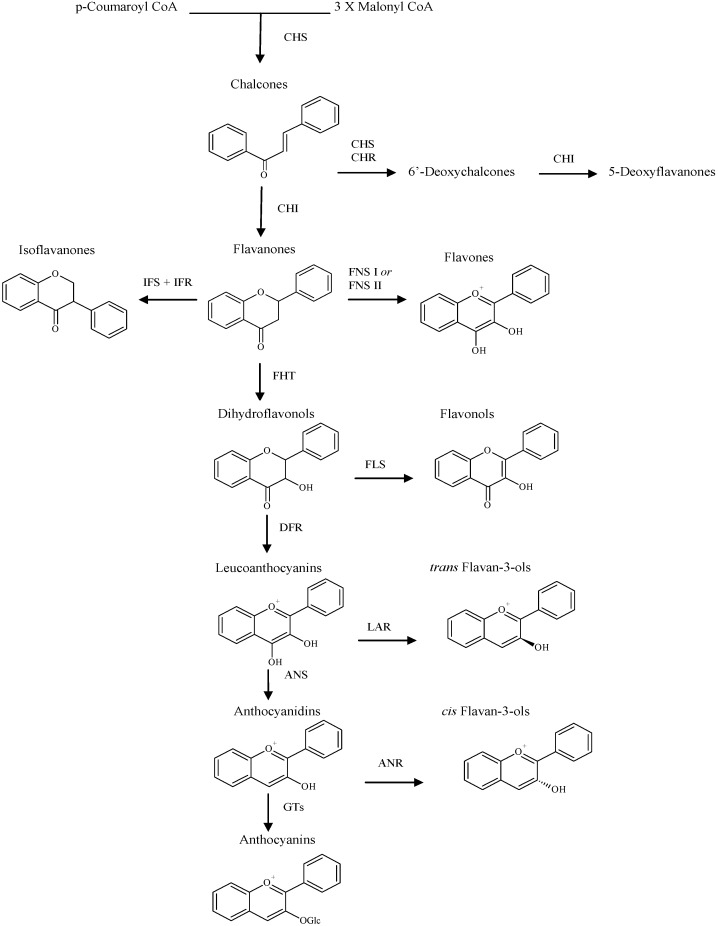Abstract
Peptic ulcers are a common disorder of the entire gastrointestinal tract that occurs mainly in the stomach and the proximal duodenum. This disease is multifactorial and its treatment faces great difficulties due to the limited effectiveness and severe side effects of the currently available drugs. The use of natural products for the prevention and treatment of different pathologies is continuously expanding throughout the world. This is particularly true with regards to flavonoids, which represent a highly diverse class of secondary metabolites with potentially beneficial human health effects that is widely distributed in the plant kingdom and currently consumed in large amounts in the diet. They display several pharmacological properties in the gastroprotective area, acting as anti-secretory, cytoprotective and antioxidant agents. Besides their action as gastroprotectives, flavonoids also act in healing of gastric ulcers and additionally these polyphenolic compounds can be new alternatives for suppression or modulation of peptic ulcers associated with H. pylori. In this review, we have summarized the literature on ninety-five flavonoids with varying degrees of antiulcerogenic activity, confirming that flavonoids have a therapeutic potential for the more effective treatment of peptic ulcers.
Keywords: Flavonoids, Gastroprotective activity, Peptic ulcers, Natural products.
Introduction
Peptic ulcers are a common disorder of the entire gastrointestinal tract [1]. They occur mainly in the stomach and the proximal duodenum. They can also occur in the esophagus, jejunum and gastric anastamotic site [2]. A peptic ulcer results from an imbalance between some endogenous aggressive factor(s) [hydrochloric acid, pepsin, refluxed bile, leukotrienes, reactive oxygen species (ROS)] and cytoprotective factors, which include the function of the mucus-bicarbonate barrier, surface active phospholipids, prostaglandins (PGs), mucosal blood flow, cell renewal and migration, nonenzymatic and enzymatic antioxidants and some growth factors [3,4,5,6]. The pathogenesis of gastric ulcers remains widespread, it is multifactorial disease where diverse factors such as a stressful lifestyle, alcohol consumption, use of steroidal and nonsteroidal antiinflammatory drugs (NSAIDs) and drugs which stimulate gastric acid and pepsin secretion, Helicobacter pylori infections, smoking, lower socio-economic status and family history all represent significant risk factors that may contribute to increasing gastric damage [3]. The prevention or cure of peptic ulcers is one of the most important challenges confronting medicine nowadays, as it is certainly a major human illness affecting nearly 8 to 10 % of the global population [7], and of these 5% suffer from gastric ulcers [3]. The prevalence of this disease is higher in men than in women [8].
Although recent advances in our understanding have highlighted the multifactorial pathogenesis of peptic ulcers, secretion of gastric acid is still recognized as a central component of this disease, therefore the main therapeutic target is the control of this secretion using antacids, H2 receptor blockers like ranitidine, famotidine, anticholinergics like pirenzepin, telezipine or proton pump blockers like omeprazole, lansoprazole, etc. [9]. However, gastric ulcer therapy faces nowadays a major drawback because most of the drugs currently available in the market show limited efficacy against gastric diseases and are often associated with severe side effects [10,11].
In this context, the use of medicinal plants is in continuous expansion all over the world for the prevention and treatment of different pathologies, and natural products are recovering space and importance in the pharmaceutical industry as inspiring sources of new potentially bioactive molecules [12]. Clinical research has confirmed the efficacy of several plants for the treatment of gastroduodenal diseases [13,14]. The medicinal properties of many plants are attributed mainly to the presence of flavonoids, but they may be also influenced by other organic and inorganic compounds such as coumarins, alkaloids, terpenoids, tannins, phenolic acids and antioxidant micronutrients, e.g., Cu, Mn, Zn [15,16].
Flavonoids represent a highly diverse class of secondary metabolites comprising about 9,000 structures that have been identified to date. They constitute the largest and most important group of polyphenolic compounds in plants. These compounds are found in all vascular plants as well as in some mosses [17,18]. The term flavonoid is used to describe plant pigments, mostly derived from benzo-γ-pyrone, which is synonymous with chromone (rings A and C in Figure 1) [19,20].
Figure 1.
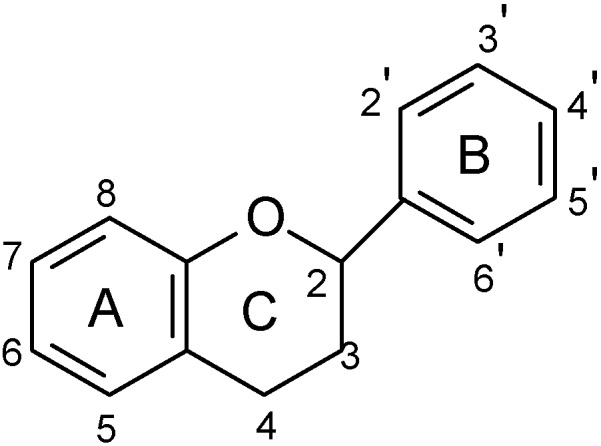
Basic flavonoid structure.
All flavonoids derive their 15-carbon skeletons (C6–C3–C6) from two basic metabolites, malonyl-CoA and p-coumaroyl-CoA. Their crucial biosynthetic reaction is the condensation of three molecules of malonyl-CoA with one molecule of p-coumaroyl-CoA to give a chalcone intermediate [21]. Chalcones act as the precursors for the vast range of flavonoid derivatives found throughout the plant kingdom. Most contain a six-membered heterocyclic ring, formed by Michael-type nucleophilic attack of a phenol group on to the unsaturated ketone giving a flavanone [22]. The first committed step of the flavonoid pathway is catalyzed by chalcone synthase (CHS; see Scheme 1). Chalcones can then be converted into aurones, a subclass of flavonoids found in certain plant species. Beyond CHS, the next step shared by most of the flavonoid biosynthesis pathways is catalyzed by chalcone isomerase (CHI), which catalyzes a stereospecific ring closure isomerization step to form the 2S-flavanones. The flavanones may represent the most important branching point in flavonoid metabolism, because isomerization of these compounds yields the others class of flavonoids [23]. However, the chemical synthesis is carried out mostly by cyclization and condensation of hydroxyacetophenone.
Scheme 1.
A schematic presentation of the flavonoid biosynthetic pathway showing the enzymatic steps leading to the major classes of end products. Enzymes are indicated with standard abbreviations.
Abbreviations: ANR, anthocyanidin reductase; ANS, anthocyanidin synthase (also known as leucoanthocyanidin dioxygenase); CHI, chalcone isomerase; CHR, chalcone reductase; CHS, chalcone synthase; DFR, dihydroflavonol 4-reductase; FNSI and FNSII, flavone synthase I and II; IFR, isoflavone reductase; IFS, isoflavone synthase; LAR, leucoanthocyanidin reductase; GTs, glucosyl transferases [21].
Taking into account the chemical nature of the molecule, and the positions of substituents on rings A, B, and C, the flavonoids are divided into 14 different groups [24]. Seven of these groups – the flavones, flavonols, flavanones, isoflavones, flavanols (catechins), flavanolols, and anthocyanidines – are particularly well known [24,25,26,27].
Flavonoids belong to the recently popular phytochemicals, chemicals derived from plant material with potentially beneficial effects on human health. The therapeutic effects of many traditional medicines may be related in many cases to the presence of these polyphenols [28]. For example, a wide variety of pharmacological activities have been reported for these substances, including antiviral [29], antiallergic [30], antiplatelet [31], antiestrogenic, anticancerogenic, anti-inflammatory, antiproliferative, antiangiogenic, and antioxidant properties, and their ingestion typically produces no or very little toxicity [24]. Flavonoids were also reported to act in the gastrointestinal tract, having antispasmodic [32], anti-secretory, antidiarrhoeal [33] and antiulcer properties [34]. Considering the important role of flavonoids in the prevention or reduction of gastric lesions induced by different ulcerogenic agents, this aim of this study was to review the literature on flavonoids with gastroprotective activity. The search was carried out on Pubmed, Schifinder School, Sciency Direct and NAPRALERT (Acronym for Natural Products ALERT) the data bank of The University of Illinois in Chicago, updated to December 2007, using “anti-ulcer flavonoids” as the search term. The references found in the search were later consulted for details on the models or mechanism based bioassays used for testing flavonoids against peptic ulcers.
Flavonoids studied in models that investigate anti-ulcer activity
In this literature review, it was possible to identify ninety-five flavonoids, whose gastroprotective activities cover a full range from inactive through weak activity to active and even strong activity. Of the flavonoids found in this study, forty-two were reportedly inactive; however, this inactivity could vary widely according to the experimental model, animal, route of administration and the dose. For example, flavonols like kaempferol, robinin and dactailin showed no gastroprotective effect in experimental models of reserpine [35,36] and restraint stress-induced ulcers in mouse [35], but kaempferol at doses of 50 and 100 mg/kg showed gastroprotective activity, and when the dose was increased to 250 mg/kg, it showed no activity [37]. Similar results were found for nobeletin, a flavone, where doses of 8 and 25 mg/kg protect the gastric mucosa of the rats from injuries induced by ethanol and HCl/ethanol, respectively, but it was only weakly active at a dose of 50 mg/kg in model of aspirin-induced ulcers [38]. Although many of the pharmacological and biochemical actions of flavonoids are attributed to their activities as antioxidants [39], this observed inactivity in high doses may be related to the capacity of flavonoids to act as pro-oxidants. Thus, flavonoids like quercetin, myricetin and kaempferol induce a concentration-dependent decrease of both the nuclear glutathione (GSH) content and glutathione S-transferase (GST) activity in a model system of isolated rat liver nuclei, which could lead to oxidative DNA damage [40], which in turn may be responsible for their mutagenicity and carcinogenicity; this effect may be explained by the pro-oxidant effects of this compounds [40, 41]. Nevertheless, the structural features that might determine the pro-oxidant activity of these compounds are not well established.
Chalcones belong to flavonoid class with the largest number of compounds with gastroprotective activity. In this review were found thirty-eight, among which we can mention sophoradin, an isoprenyl chalcone, which is present in a Chinese crude drug (the root of Sophora subprostrata) and protects the gastric mucosa from lesions induced by pylorus-ligation and water-immersion stress [42,43]. Thirty sophoradin analogs have shown anti-ulcer effects in the same ulcer induction models. Several chalcones, all having more than one isoprenyloxyl group, exhibited high inhibitory ratios. In particular, 2’,4’-dihydroxy-3’-(3-methyl-2-butenyl)-4-(3-methyl-2-butenyloxy) chalcone, 2’-hydroxy-4,4’-bis(3-methyl-2-butenyloxy) chalcone and 2’-carboxymethoxy-4,4’-bis(3-methyl-2-butenyloxy) chalcone (sofalcone), showed strong activity at a dose of 100 mg/kg, with a high percentage of inhibition of lesions (70-100%), when compared to other chalcones at the same dose and were as potent as sophoradin [42]. Sofalcone is one of these analogs that in addition to its gastroprotective effects also accelerates ulcer healing [44]. The mechanisms of action involved in gastric protection are increased gastric blood flow, stimulated synthesis of mucosubstances of the gastric mucosa [45] and increasing effects on gastric tissue PGs contents [46]. Besides its cytoprotective effects, sofalcone has a direct bactericidal effect on H. pylori, with a minimum inhibitory concentration of 55-222 µmol/L, anti-urease activity and it reduces the adhesion of this organism to gastric epithelial cells [47,48]. When outpatients with peptic ulcers and H. pylori infections were medicated for 7 d with sofalcone (100 mg thrice daily) plus the triple therapy with rabeprazole (10 mg twice daily), clarithromycin (200 mg twice daily) and amoxicillin (750 mg twice daily), sofalcone significantly increased the cure rate of H. pylori infections [49]. Therefore flavonoids can be utilized as alternative or additive agents to the current therapy in treatment of peptic ulcer induced by H. pylori infection.
Another flavonoid that appears to exert anti-ulcer activity is monomeric leucocyanidin, a natural flavonoid and the major component present in unripe plantain banana (Musa sapientum L. var. paradisiaca). It and its synthetic analogues hydroxyethylated leucocyanidin and tetrallylleucocyanidin showed protective effects against aspirin-induced gastric erosions in a prophylactic animal model, as shown by the absence of mucosal damage and a significant reduction in the ulcer index, when added to the diet at 5 mg and 15 mg per day [50,51]. The authors concluded that these compounds may be responsible for the displayed anti-ulcer properties and they suggested that the mechanism by which the active agent present in plantain banana and its synthetic analogues protects the mucosa is mediated, at least in part, by an increase in mucus thickness [51].
Another polyphenolic compound with relevant activities is garcinol, a polyisoprenylated benzophenone derivative from Garcinia indica, which shows potent free radical scavenging activity in three kinds of free radical generating systems. In the hypoxanthine/xanthine oxidase system, emulsified garcinol suppressed superoxide anion to almost the same extent as dl-α-tocopherol by weight and also suppressed hydroxyl radical more strongly than dl-α-tocopherol in the Fenton reaction system. In the H2O2/NaOH/DMSO system, this compound suppressed superoxide anion, hydroxyl radical, and methyl radical. Orally administered garcinol prevented acute ulceration in rats induced by indomethacin (40-200 mg/kg) and water immersion stress (200 mg/kg) caused by radical formation. These results suggested that garcinol might have potential as a free radical scavenger and clinical applications as an anti-ulcer drug. Although the mechanism of its anti-ulcer activity is not yet understood, garcinol may scavenge reactive oxygen species on the surface of gastric mucosa, thus protecting cells from injury [52].
A flavonoid that has been studied in some detail is rutin (quercetin-3-rhamnosylglucoside), a natural flavone derivative. It has been reported to prevent gastric mucosal ulceration in animal models including reserpine [35], acidified ethanol [37] and absolute and 50% ethanol [34,37]. The cytoprotective effect of this flavonoid does not appear to be mediated by endogenous prostaglandins [53], but its protective effects may be mediated by endogenous platelet-activating factor (PAF), since it inhibited dose-dependently the mucosal content of PAF [37]. Another possible mechanism involves the antioxidant properties of rutin, which at a dose of 200 mg/kg has a protective effect against lesions induced by 50 % ethanol, probably by reducing the levels of lipoperoxides and increasing the activity of the antioxidant enzyme glutathione peroxidase (GSH-Px). However, no significant modifications were observed in the gastric non-protein sulfhydryl (SH) content or in the ethanol-induced leukocyte infiltrate [34].
One of the most studied flavonoids is quercetin (3,3’,4’,5,7-pentahydroxyflavone). It protects the gastrointestinal mucosa from acute lesions induced by various experiemental models and against different necrotic agents, including restraint stress [37,54,55] pylorus-ligation [56], reserpine [35,36,55,57], aspirin [54], indomethacin [58], acid-ethanol [37] and ethanol-induced gastric ulcers [54,59,60]. Its gastroprotective action mechanism involves endogenous PAF [37], an increase in mucus production [58], antihistaminic properties, which decrease histamine levels and reduction of the number of ethanol-induced mast cells. It also inhibits H. pylori growth, the formation of acid by parietal cells in response to stimulation by histamine and dibutyryl cyclic AMP, as well as the gastric H+/K+ proton pump (data not shown in Table 1) [61]. The main mechanism of action for the gastroprotective effects of this flavonol are its antioxidant properties, since oral pretreatment with quercetin (200 mg/kg) had protective effects in that it significantly reduced the severity of ethanol-induced ulcers by inhibition of lipid peroxidation, enhancement in the levels of mucosal non-protein SH compounds (important antioxidant agents) [59,60] in GSH-Px [59] and superoxide dismutase activities, as well as reduction of protein carbonyl compounds [60]. At a dose of 100 mg/kg twice daily for 5 days it also decreases lipid peroxidation and plasmatic corticosterone in a restraint stress model. This flavonoid, in addition to protecting the gastric mucosa in acute models of ulcer induction, when administered chronically both quercetin and naringenin also promote healing of gastric ulcers induced by acetic acid, a chronic model of ulcer [62]. The antioxidant mechanism of action of flavonoids, especially garcinol, rutin and quercetin, is due mainly the presence in their structures of an o-dihydroxy in the B ring (catechol), and additionally a 2,3 double bond in conjugation with a 4-oxo function, as well as the presence of hydroxyl groups in positions 3, 5 and 7 [24,63,64]
Table 1.
Flavonoids with gastroprotective activity.
| Substance | Experimental assay/Administration route | Animal tested | Dose | Activity |
|---|---|---|---|---|
| Chalcones | ||||
Butein
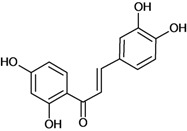
|
HCl/ethanol-induced ulcers/intragastric | Rat | 10 mg/kg | Active [65] |
| NaOH-induced ulcers/intragastric | Rat | 50.0 mg/kg | Inactive [65] | |
2',3,4,4',6'-pentahydroxychalcone
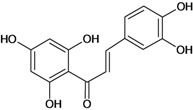
|
HCl/ethanol-induced ulcers/intragastric | Rat | 10.0 mg/kg | Active [65] |
| NaOH-induced ulcers/intragastric | Rat | 10.0 mg/kg | Active [65] | |
2',3,4-trihydroxychalcone
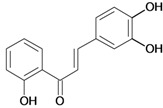
|
HCl/ethanol-induced ulcers/intragastric | Rat | 10.0 mg/kg | Active [65] |
| NaOH-induced ulcers/intragastric | Rat | 10.0 mg/kg | Active [65] | |
2',4',6'-trihydroxychalcone
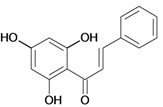
|
HCl/ethanol-induced ulcers/intragastric | Rat | 10.0 mg/kg | Active [65] |
| NaOH-induced ulcers/intragastric | Rat | 10.0 mg/kg | Active [65] | |
2',4'-dihydroxy-3',5'-diprenyl-4-O-prenyl- chalcone
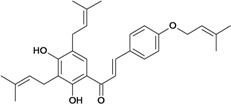
|
Stress-induced ulcers (water-immersion)/i.p. | Rat | 100.0 mg/kg | Active [42] |
2',4'-dihydroxy-3'-methoxychalcone
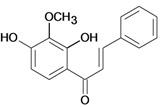
|
Ethanol-induced ulcers/intragastric | Mouse | * | Weak Active [66] |
| Ethanol-induced ulcers/intragastric | Rat | 100.0 mg/kg | Active [67] | |
| Ethanol-induced ulcers/intragastric | Rat | * | Active [66] | |
2',4'-dihydroxy-5'-prenyl-4-O-prenyl- chalcone
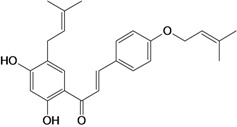
|
Pylorus ligation-induced ulcers/i.p. | Rat | 100.0 mg/kg | Active [42] |
| Stress-induced ulcers (water-immersion)/i.p. | Rat | 100.0 mg/kg | Active [42] | |
2',4'-dihydroxychalcone
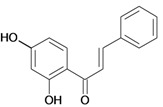
|
Stress-induced ulcers (water-immersion)/intragastric | Rat | 10.0 mg/kg | Active [65] |
| Acetic acid-induced ulcers/intragastric | Rat | 10.0 mg/kg | Active [65] | |
| HCl/ethanol-induced ulcers/intragastric | Rat | 10.0 mg/kg | Active [65] | |
| NaOH-induced ulcers/intragastric | ||||
| Ethanol-induced ulcers/intragastric | Rat | 10.0 mg/kg | Active [65] | |
| Ethanol-induced ulcers/intragastric | Mouse | * | Active [66] | |
| Ethanol-induced ulcers/intragastric | Rat | 100 mg/kg | Active [67] | |
| Rat | * | Active [66] | ||
2',4,4',6'-tetrahydroxychalcone
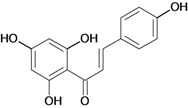
|
HCl/ethanol-induced ulcers/intragastric | Rat | 10.0 mg/kg | Inactive [65] |
| NaOH-induced ulcers/intragastric | Rat | 10.0 mg/kg | Active [65] | |
2',4,4'-trihydroxy-3,3',5'-tris-(3-methyl-but-2-enyl) chalcone
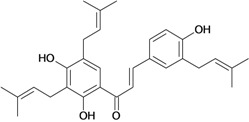
|
*/* | Rat | * | Active [68] |
2',4,4'-trihydroxy-3,3',5,5'-tetrakis-(3-methyl-but-2-enyl)-4,4'-bis-(O-3-methyl-but-2-enyl) chalcone
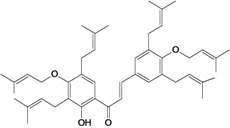
|
*/* | Rat | * | Active [69] |
2',4,4'-trihydroxy-3,3',5,5'-tetrakis-3-methyl-but-2-enyl) chalcone
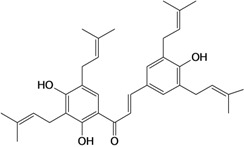
|
*/* | Rat | * | Active [68] |
2',4,4'-trihydroxy-3,3',5-tris-(3-methyl-but-2-enyl)-4-4'-di-O-allyl chalcone
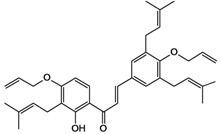
|
*/* | Rat | * | Active [69] |
2',4,4'-trihydroxy-3,3'-bis-(3-methylbut-2-enyl) chalcone

|
*/* | Rat | * | Active [68] |
2',4,4'-trihydroxy-3,3'-diprenylchalcone
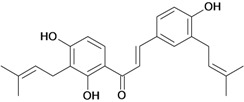
|
Stress-induced ulcers (water-immersion)/i.p. | Rat | 100.0 mg/kg | Active [42] |
2',4,4'-trihydroxy-3,5,5'-tris-(3-methyl-but-2-enyl)-4'-O-(3-methylbut-2-enyl) chalcone
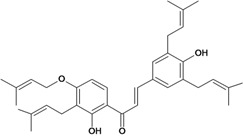
|
*/* | Rat | * | Active [69] |
2',4,4'-trihydroxychalcone
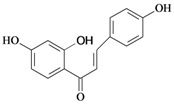
|
HCl/ethanol-induced ulcers/intragastric | Rat | 10.0 mg/kg | Active [65] |
| NaOH-induced ulcers/intragastric | Rat | 10.0 mg/kg | Active [65] | |
2',4-dihydroxy-3-prenyl-4'-O-prenyl- chalcone

|
Stress-induced ulcers (water-immersion)/i.p. | Rat | 100.0 mg/kg | Active [42] |
2',4-dihydroxy-4'-methoxy-3-5-bis-(3-methyl-but-2-enyl) chalcone
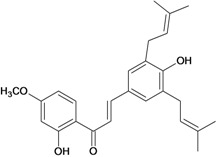
|
*/* | Rat | * | Active [42] |
2'-carbomethoxy-4,4'-bis-(3-methyl-2-butenyl-oxy) chalcone (sofalcone)
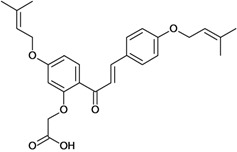
|
Histamine-induced ulcers/i.p. | Rat | 100.0 mg/kg | Active [45] |
| Acetic acid-induced ulcers/gastric intubation | Rat | 20-50 mg/kg | Active [45] | |
| Histamine-induced ulcers/gastric intubation | Guinea pig | 100.0 mg/kg | Active [45] | |
| Pylorus ligation-induced ulcers/i.p. | Rat | 50.0 mg/kg | Active [45] | |
| Stress-induced ulcers (water-immersion)/i.p. | Rat | 50.0 mg/kg | Active [45] | |
| Phenylbutazone-induced ulcers/gastric ntubation | Rat | 300.0 mg/kg | Active [45] | |
| Acetic acid-induced ulcers/gastric intubation | Rat | 50.0 mg/kg | Active [44] | |
| HCl induced gastric lesions/i.p. | Rat | 100.0 mg/kg | Active [46] | |
| HCl induced gastric lesions/gastric intubation | Rat | 100.0 mg/kg | Active [46] | |
| Pretreatment with indomethacin vs HCl induced gastric lesions/gastric intubation | Rat | 300.0 mg/kg | Active [46] | |
| Pretreatment with indomethacin vs HCl induced gastric lesions/i.p. | Rat | 100.0 mg/kg | Active [46] | |
| H. pylori induced ulcer/p.o. | Human adult | 100.0 mg/kg | Active [49] | |
2'-hydroxy-4,4'-di-O-prenylchalcone

|
Pylorus ligation-induced ulcers/i.p. | Rat | 100.0 mg/kg | Strong activity [42] |
| Stress-induced ulcers (water-immersion)/i.p. | Rat | 100.0 mg/kg | Strong activity [42] | |
2,4'-di-O-prenylchalcone
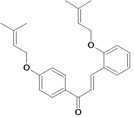
|
Pylorus ligation-induced ulcers/i.p. | Rat | 100.0 mg/kg | Active [42] |
| Stress-induced ulcers (water-immersion)/i.p. | Rat | 100.0 mg/kg | Weak activity [42] | |
2,4,4'-trihydroxy-3,3',5'-tris-(3-methyl-but-2-enyl)-4-O-allyl-4-O-propargyl-chalcone
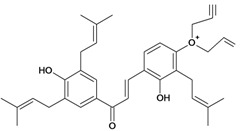
|
*/* | Rat | * | Active [69] |
3',5'-dihydroxy-4'-prenyl-5-O-prenyl- chalcone
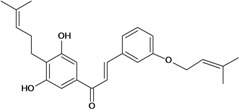
|
Pylorus ligation-induced ulcers/i.p. | Rat | 100.0 mg/kg | Strong activity [42] |
| Stress-induced ulcers (water-immersion)/i.p. | Rat | 100.0 mg/kg | Strong activity [42] | |
3,3',4-trihydroxychalcone
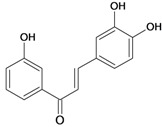
|
HCl/ethanol-induced ulcers/intragastric | Rat | 10.0 mg/kg | Active [65] |
| NaOH-induced ulcers/intragastric | Rat | 10.0 mg/kg | Active [65] | |
3,4,4'-trihydroxychalcone
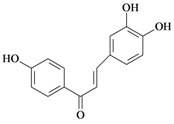
|
HCl/ethanol-induced ulcers/intragastric | Rat | 10.0 mg/kg | Inactive [65] |
| NaOH-induced ulcers/intragastric | Rat | 10.0 mg/kg | Active [65] | |
4'-hydroxy-3'-prenyl-4-O-prenylchalcone

|
Pylorus ligation-induced ulcers/i.p. | Rat | 100.0 mg/kg | Active [42] |
| Stress-induced ulcers (water-immersion)/i.p. | Rat | 100.0 mg/kg | Strong activity [42] | |
4,4'-di-O-geranyl chalcone

|
Pylorus ligation-induced ulcers/i.p. | Rat | 100.0 mg/kg | Weak activity [42] |
| Stress-induced ulcers (water-immersion)/i.p. | Rat | 100.0 mg/kg | Weak activity [42] | |
4,4'-di-O-prenylchalcone

|
Pylorus ligation-induced ulcers/i.p. | Rat | 100.0 mg/kg | Active [42] |
| Stress-induced ulcers (water-immersion)/i.p. | Rat | 100.0 mg/kg | Strong activity [42] | |
4,4'-dihydroxy-3,3'-diprenylchalcone
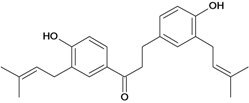
|
Stress-induced ulcers (water-immersion)/i.p. | Rat | 100.0 mg/kg | Active [42] |
4,4'-dimethoxy-3,3'-diprenylchalcone
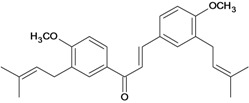
|
Pylorus ligation-induced ulcers/i.p. | Rat | 100.0 mg/kg | Weak activity [42] |
| Stress-induced ulcers (water-immersion)/i.p. | Rat | 100.0 mg/kg | Active [42] | |
4-hydroxy-3-prenyl-4'-O-prenylchalcone
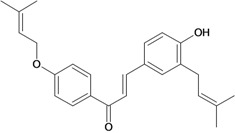
|
Pylorus ligation-induced ulcers/i.p. | Rat | 100.0 mg/kg | Active [42] |
| Stress-induced ulcers (water-immersion)/i.p. | Rat | 100.0 mg/kg | Weak activity [42] | |
2',4-bis-(carbomethoxy)-4'-(3-carboxy-2-butenyl-oxy) dihydrochalcone
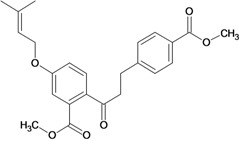
|
Pylorus ligation-induced ulcers/i.p. | Rat | 100.0 mg/kg | Weak activity [70] |
| Stress-induced ulcers (water-immersion)/i.p. | Rat | 100.0 mg/kg | Weak activity [70] | |
| Histamine-induced ulcers/i.p. | Rat | 100.0 mg/kg | Weak activity [70] | |
2',4-bis-(carboxymethoxy)-4'-(3-methyl-2-butenyl-oxy) dihydrochalcone
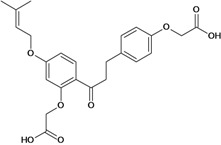
|
Pylorus ligation-induced ulcers/i.p. | Rat | 100.0 mg/kg | Active [70] |
| Stress-induced ulcers (water-immersion)/i.p. | Rat | 100.0 mg/kg | Weak activity [70] | |
| Histamine-induced ulcers/i.p. | Rat | 100.0 mg/kg | Active [70] | |
2'-carboxymethoxy-4-4'-bis-(3-methyl-2-butenyl-oxy) dihydro-chalcone
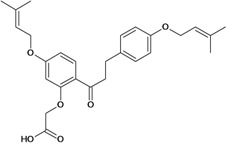
|
Pylorus ligation-induced ulcers/i.p. | Rat | 100.0 mg/kg | Active [70] |
| Stress-induced ulcers (water-immersion)/i.p. | Rat | 100.0 mg/kg | Active [70] | |
| Histamine-induced ulcers/i.p. | Rat | 100.0 mg/kg | Active [70] | |
Garcinol
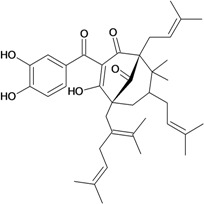
|
Stress-induced (restraint) ulcers/intragastric | Rat | 200.0 mg/kg | Active [52] |
| Indomethacin-induced ulcers/intragastric | Rat | 200.0 mg/kg | Active [52] | |
Sophoradin
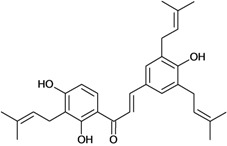
|
Pylorus ligation-induced ulcers/p.o. | Rat | * | Active [43] |
| Stress-induced ulcers/p.o. | Rat | * | Active [43] | |
| Pylorus ligation-induced ulcers/p.o. | Rat | 100.0 mg/kg | Strong activity [42] | |
| Stress-induced ulcers/p.o. | Rat | 100.0 mg/kg | Strong activity [42] | |
Xanthoangelol E
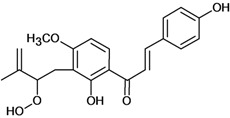
|
Stress-induced (restraint) ulcers/intragastric | Rat | 100.0 mg/kg | Active [71] |
| Flavanones | ||||
3',4',5,7-tetrahydroxy-3-methoxy- flavanone
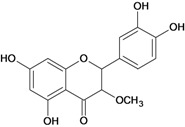
|
stress-induced (restraint) ulcers/* | Rat | * | Active [72] |
2',4',7-trihydroxy-5-methoxy-8-(5-hydroxy-5-methyl-2-iso-propenyl-hexyl) flavanone
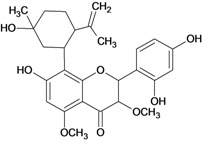
|
*/p.o. | Human adult | * | Active [73] |
Hesperidin
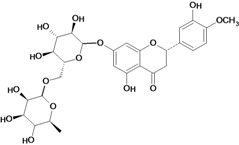
|
Cold stress-induced ulcers/intragastric | Rat | 100.0 mg/kg | Active [74] |
| Ethanol-induced ulcers/intragastric | Rat | 100.0 mg/kg | Inactive [74] | |
Naringenin
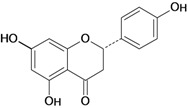
|
Acetic acid-induced ulcers/intragastric | Rat | 100.0 mg/kg | Active [62] |
| Stress-induced ulcers (water-immersion)/intragastric | Rat | 100.0 mg/kg | Weak active [56] | |
| Pylorus ligation-induced ulcers/intragastric | Rat | 100.0 mg/kg | Active [56] | |
| Pylorus ligation-induced ulcers /intragastric | Rat | 100.0 mg/kg | Active [56] | |
| Pylorus ligation-induced ulcers/gastric intubation | Rat | ED50 132 mg/kg | Active [75] | |
| Stress-induced (restraint) ulcers/gastric intubation | Rat | ED50 42.0 mg/kg | Active [75] | |
| Aspirin-induced ulcers/gastric intubation | Rat | * | Active [75] | |
| Phenylbutazone-induced ulcers/gastric intubation | Rat | * | Active [75] | |
| Reserpine-induced ulcers/gastric intubation | Rat | * | Active [75] | |
Naringin
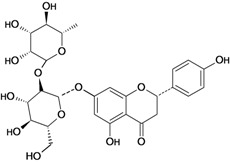
|
Aspirin-induced ulcers/intragastric | Rat | 200.0 mg/kg | Active [76] |
| Acid-ethanol-induced ulcers/i.p. | Rat | 100.0 mg/kg | Inactive [37] | |
| Acid-ethanol-induced ulcers/i.p. | Rat | 200.0 mg/kg | Active [37] | |
| Acid-ethanol-induced ulcers/i.p. | Rat | 400.0 mg/kg | Active [37] | |
| Ethanol-induced gastric injury/intragastric | Rat | 400.0 mg/kg | Active [37] | |
Sigmoidin A
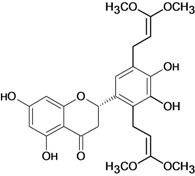
|
Stress-induced ulcers (water-immersion)/gastric intubation | Rat | 50.0 mg/kg | Active [78] |
| Stress-induced (restraint) ulcers/gastric intubation | Rat | 50.0 mg/kg | Active [78] | |
Sigmoidin B
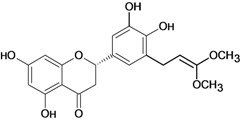
|
Stress-induced ulcers (water-immersion)/gastric intubation | Rat | 50.0 mg/kg | Active [78] |
| Stress-induced (restraint) ulcers/gastric intubation | Rat | 50.0 mg/kg | Active [78] | |
Sophoranone
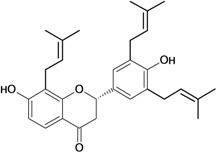
|
Pylorus ligation-induced ulcers/p.o. | Rat | * | Active [43] |
| Stress-induced ulcers/p.o. | Rat | * | Active [43] | |
| Flavane and Flavanols | ||||
(+) catechin
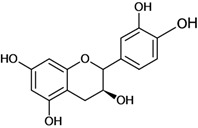
|
HCl/ethanol-induced stomach ulcers/intragastric | Rat | * | Inactive [79] |
| */pathway oral (p.o.) | Rat | 100.0 mg/kg | Active [80] | |
| Reserpine-induced ulcers/gastric intubation | Mouse | 49.7 mg/kg | Equivocal [57] | |
| Reserpine-induced ulcers/gastric intubation | Mouse | 72.5 mg/kg | Inactive [57] | |
| Stress-induced ulcers (water-immersion)/gastric intubation | Mouse | 500.0 mg/kg | Weak Active [81] | |
(dl) catechin
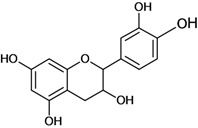
|
Stress-induced (restraint) ulcers/subcutaneous (s.c.) | Mouse | 300.0 mg/kg | Active [82] |
| Stress-induced (restraint) ulcers/intragastric | Mouse | 300.0 mg/kg | Active [82] | |
| Stress-induced ulcers (water-immersion)/s.c. | Mouse | 300.0 μmol/kg | Active [82] | |
| Stress-induced ulcers (water-immersion)/intragastric | Mouse | 300.0 mg/kg | Active [82] | |
3-O-methyl: (+) catechin
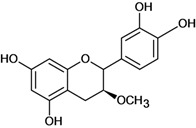
|
Pylorus ligation-induced ulcers/s.c. | Rat | ED50 60.0 mg/kg | Active [83] |
| Stress-induced (restraint) ulcers/s.c. | Rat | ED50 13.2 mg/kg | Active [83] | |
| */s.c. | Rat | * | Active [83] | |
| Phenylbutazone-induced ulcers/s.c. | Rat | * | Active [83] | |
| Reserpine-induced ulcers/s.c. | Rat | * | Active [83] | |
| */* | * | * | Active [84] | |
(-) Epicatechin
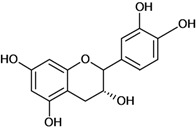
|
Stress-induced ulcers (water-immersion)/gastric intubation | Mouse | 500.0 mg/kg | Weak Active [81] |
(+) Cyanidan-3-beta- ol
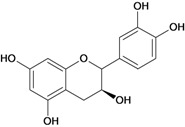
|
Pylorus ligation-induced ulcers/s.c. | Rat | ED50 62 mg/kg | Active [85] |
| Restraint-induced ulcers/s.c. | Rat | ED50 18 mg/kg | Active [85] | |
| Aspirin-induced ulcers/gastric intubation | Rat | 100.0 mg/kg | Active [85] | |
| Phenylbutazone-induced ulcers/gastric intubation | Rat | 100.0 mg/kg | Active [85] | |
| Ibuprofen-induced ulcers/gastric intubation | Rat | 100.0 mg/kg | Active [85] | |
| Reserpine-induced ulcers/gastric intubation | Rat | 100.0 mg/kg | Active [85] | |
Leucocyanidin
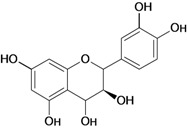
|
Aspirin-induced ulcers/* | Rat | 5.0 mg/day | Active [50] |
| */intragastric | Rat | * | Active [51] | |
| Flavanolols | ||||
Taxifolin
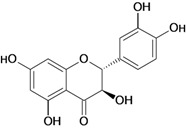
|
Ethanol induced gastric ulcers/intragastric | Rat | 50.0 mg/kg | Active [86] |
Taxifolin,(dl)
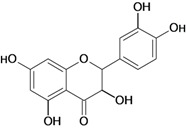
|
HCl /ethanol-induced stomach ulcers/intragastric | Rat | * mg/kg | Inactive [79] |
| Anthocyanidines | ||||
Benzopyrylium chloride,1: 3,5,7- trihydroxy-2-(3-4-dihydroxyphenyl)
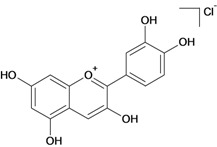
|
Pylorus ligation-induced ulcers/intragastric | Rat | 12.5 mg/kg | Active [87] |
| Stress-induced (restraint) ulcers/intragastric | Rat | 100.0 mg/kg | Active [87] | |
| Phenylbutazone-induced ulcers/intragastric | Rat | 22.0 mg/kg | Active [87] | |
| Indomethacin-induced ulcers/intragastric | Rat | 100.0 mg/kg | Active [87] | |
| Reserpine-induced ulcers/intragastric | Rat | 100.0 mg/kg | Active [87] | |
| Ethanol induced lesion/intragastric | Rat | 200.0 mg/kg | Active [87] | |
| Histamine-induced ulcers/intragastric | Rat | 24.0 mg/kg | Active [87] | |
| Cysteamine-induced ulcers/intragastric | Rat | 200.0 mg/kg | Active [87] | |
| Cysteamine-induced ulcers/intraperitoneal (i.p.) | Rat | 50.0 mg/kg | Active [87] | |
| Acetic acid-induced ulcers/intragastric | Rat | 50.0 mg/kg | Active [87] | |
| Flavones | ||||
Acacetin
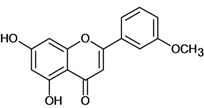
|
Reserpine-induced ulcers/gastric intubation | Mouse | 0.05 mL/g | Inactive [36] |
Apigenin
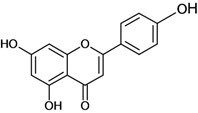
|
Reserpine-induced ulcers/gastric intubation | Mouse | 0.05 mL/g | Inactive [36] |
Cynaroside
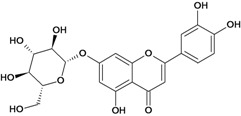
|
*/intragastric | Rat | * | * [88] |
Dactylin
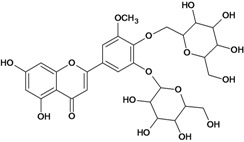
|
Reserpine-induced ulcers/gastric intubation | Mouse | * | Inactive [35] |
| Stress-induced (restraint) ulcers/gastric intubation | Mouse | * | Inactive [35] | |
Eupatilin
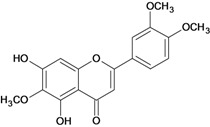
|
*/ Intragastric | Rat | * | Active [89] |
Gnaphaloside A
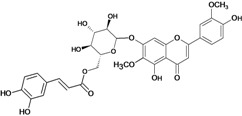
|
Reserpine-induced ulcers/gastric intubation | Mouse | 0.05 mL/g | Active [36] |
Gossypin
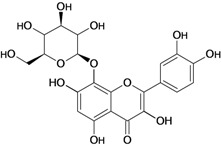
|
*/oral | Rat | 100.0 mg/kg | Active [80] |
Hyperoside
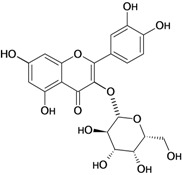
|
Reserpine-induced ulcers/gastric intubation | Mouse | * | Weak activity [35] |
| Stress-induced (restraint) ulcers/gastric intubation | Mouse | * | Weak activity [35] | |
Hypolaetin-8-O-beta-d-glucoside
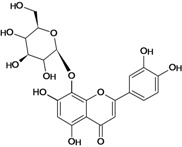
|
Cold stress-induced ulcers/i.p. | Rat | ED50 573mg/kg | Active [90] |
| Cold stress-induced ulcers/* | * | ED50 57.3mg/kg | Active [91] | |
| Ethanol-induced gastric lesions/s.c. | Rat | ED50 68.0mg/kg | Active [92] | |
Kaempferol rhamnoside
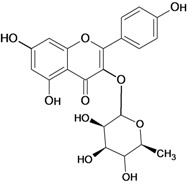
|
Reserpine-induced ulcers/gastric intubation | Mouse | 0.05 mL/g | Active [36] |
Linarin
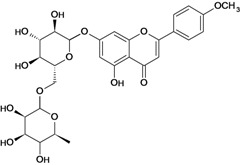
|
Reserpine-induced ulcers/gastric intubation | Mouse | 0.05 mL/g | Inactive [36] |
Luteolin
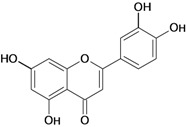
|
*/intragastric | Rat | * | Active [88] |
| Reserpine-induced ulcers/gastric intubation | Mouse | 47.4 mg/kg | Active [57] | |
| Reserpine-induced ulcers/gastric intubation | Mouse | 474 mg/kg | Active [57] | |
Myricetin rhamnoside
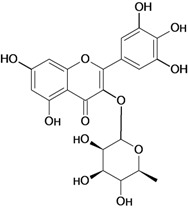
|
Reserpine-induced ulcers/gastric intubation | Mouse | 0.05 mL/g | Active [36] |
Nobiletin
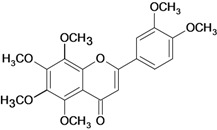
|
Ethanol-induced gastric ulcer/intragastric | Rat | ED50 8.0 mg/kg | Active [38] |
| Ethanol-induced ulcers/intragastric | Rat | ED50 8.0 mg/kg | Active [93] | |
| Aspirin-induced ulcers/intragastric | Rat | 50.0 mg/kg | Weak active [93] | |
| HCl/ethanol-induced gastric ulcers/intragastric | Rat | 25.0 mg/kg | Active [97] | |
Pectolinarigenin
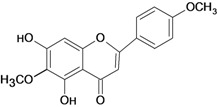
|
Reserpine-induced ulcers/gastric intubation | Mouse | 0.05 mL/g | Inactive [36] |
Pectolinarin
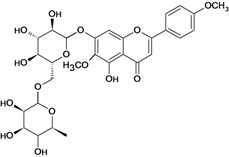
|
Reserpine-induced ulcers/gastric intubation | Mouse | 0.05 mL/g | Inactive [36] |
Acetyl pectolinarin
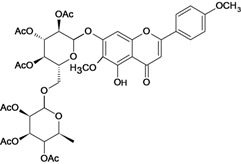
|
Reserpine-iduced ulcers/gastric itubation | Mouse | 0.05 mL/g | Inactive [36] |
Quercetin rhamnoside
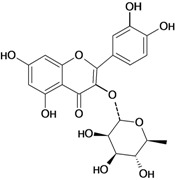
|
Reserpine-induced ulcers/gastric intubation | Mouse | 0.05 mL/g | Active [36] |
Quercitrin
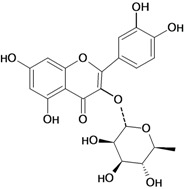
|
Reserpine-induced ulcers/gastric intubation | Mouse | 50.0 mg/g | Active [57] |
Robinin
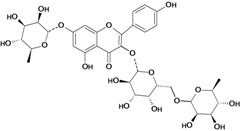
|
Reserpine-induced ulcers/gastric intubation | Mouse | * | Inactive [36] |
| Stress-induced (restraint) ulcers/gastric intubation | Mouse | * | Inactive [36] | |
Rutin
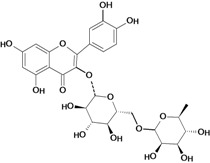
|
Acid-ethanol-induced ulcers/i.p. | Mouse | 12.5 mg/kg | Inactive [37] |
| Acid-ethanol-induced ulcers/i.p. | Rat | 25.0 mg/kg | Active [37] | |
| Acid-ethanol-induced ulcers/i.p. | Rat | 50.0 mg/kg | Active [37] | |
| Pretreatment with indomethalin vs ethanol induced-ulcers/intragastric | Rat | 25.0 mg/kg | Weak activity [53] | |
| Ethanol-induced ulcers/intragastric | Rat | 50.0 mg/kg | Active [53] | |
| Ethanol-induced ulcers/ intragastric | Rat | 200.0 mg/kg | Active [34] | |
| */intragastric | Mouse | 7.0 mg/kg | Active [95] | |
| */intragastric | Mouse | * | Active [96] | |
| Reserpine-induced ulcers/gastric intubation | Mouse | * | Weak activity [35] | |
| Stress-induced (restraint) ulcers/gastric intubation | Mouse | * | Weak activity [35] | |
Salvigenin
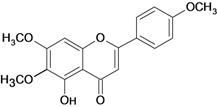
|
Pylorus ligation-induced ulcers/i.p. | Rat | 100.0 mg/kg | Inactive [97] |
Scoparin
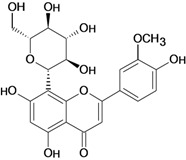
|
Reserpine-induced ulcers/gastric intubation | Mouse | 0.05 mL/g | Inactive [36] |
Ternatin
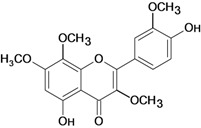
|
Cold stress-induced ulcers/i.p. | Rat | 25.0 mg/kg | Inactive [98] |
| Ethanol-induced ulcers/i.p. | Rat | 25.0 mg/kg | Inactive [98] | |
| Indomethacin-induced ulcers/i.p. | Rat | 25.0 mg/kg | Inactive [98] | |
Vexibinol
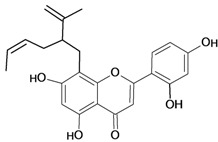
|
HCl-ethanol induced ulcers/intragastric | Rat | 10.0 mg/kg | Active [99] |
| Stress-induced ulcers (water-immersion)/intragastric | Rat | 10.0 mg/kg | Active [99] | |
| Pylorus ligation-induced ulcers/intragastric | Rat | 100.0 mg/kg | Active [99] | |
| Indomethacin-induced ulcers/intragastric | Rat | 100.0 mg/kg | Active [99] | |
| Histamine-induced ulcers/intragastric | Rat | 100.0 mg/kg | Inactive [99] | |
| 5-Ht-induced ulcers/intragastric | Rat | 300.0 mg/kg | Inactive [99] | |
| Phenylbutazone induced ulcers/intragastric | Rat | 300.0 mg/kg | Active [99] | |
| Isoflavones | ||||
Genistin

|
*/intragastric | Rat | * | Active [88] |
| Flavonols | ||||
Kaempferol
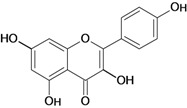
|
Acid-ethanol-induced ulcers/i.p. | Rat | 250.0 mg/kg | Inactive [37] |
| Acid-ethanol-induced ulcers/i.p. | Rat | 50.0 mg/kg | Active [37] | |
| Acid-ethanol-induced ulcers/i.p. | Rat | 100.0 mg/kg | Active [37] | |
| Ethanol-induced ulcers/i.p. | Rat | 100.0 mg/kg | Active [100] | |
| Cold stress-induced ulcers/i.p. | Rat | 200.0 mg/kg | Active [100] | |
| Reserpine-induced ulcers/gastric intubation | Mouse | 0.05 mL/g | Inactive [36] | |
| Pylorus ligation-induced ulcers/i.p. | Rat | 200.0 mg/kg | Active [101] | |
| Stress-induced (restraint) ulcers/i.p. | Rat | 200.0 mg/kg | Active [101] | |
| Reserpine-induced ulcers/gastric intubation | Mouse | * | Inactive [35] | |
| Stress-induced (restraint) ulcers/gastric | Mouse | * | Inactive [35] | |
Myricetin
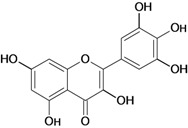
|
Reserpine-induced ulcers/gastric intubation | Mouse | 0.05 mL/g | Inactive [36] |
| Reserpine-induced ulcers/gastric intubation | Mouse | 0.05 mL/g | Active [36] | |
| Reserpine-induced ulcers/gastric intubation | Mouse | * | Active [55] | |
| Stress-induced (restraint) ulcers/gastric intubation | Mouse | * | Active [55] | |
| Reserpine-induced ulcers/gastric intubation | Mouse | * | Active [35] | |
| Stress-induced (restraint) ulcers/gastric intubation | Mouse | * | Active [35] | |
Patuletin
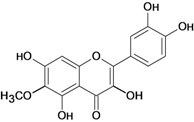
|
Reserpine-induced ulcers/gastric intubation | Mouse | 0.05 mL/g | Inactive [36] |
Patulitrin
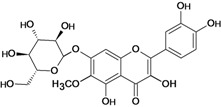
|
Reserpine-induced ulcers/gastric intubation | Mouse | 0.05 mL/g | Weak active [36] |
Phellavin
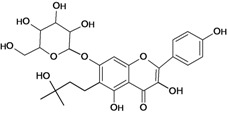
|
Reserpine-induced ulcers/gastric intubation | Mouse | 0.05 mL/g | Inactive [36] |
Quercetin
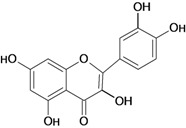
|
Ethanol-induced gastric lesions/intragastric | Rat | 200.0 mg/kg | Active [59] |
| Acetic acid-induced ulcers/intragastric | Rat | 100.0 mg/kg | Active [62] | |
| Stress-induced ulcers (water-immersion)/intragastric | Rat | 100.0 mg/kg | Active [56] | |
| Pylorus ligation-induced ulcers/intragastric | Rat | 100.0 mg/kg | Active [56] | |
| Pylorus ligation-induced ulcers/intragastric | Rat | 100.0 mg/kg | Active [56] | |
| */intragastric | Rat | 200.0 mg/kg | Active [58] | |
| Acid-ethanol-induced ulcers/i.p. | Rat | 12.5 mg/kg | Inactive [37] | |
| Acid-ethanol-induced ulcers/i.p. | Rat | 25.0 mg/kg | Active [37] | |
| Acid-ethanol-induced ulcers/i.p. | Rat | 50.0 mg/kg | Active [37] | |
| Ethanol-induced gastric ulcers/i.p. | Rat | 12.5 mg/kg | Active [104] | |
| */ intragastric | Mouse | * | Active [96] | |
| Ethanol-induced ulcers/intragastric | Rat | 100.0 mg/kg | Active [54] | |
| Stress-induced (restraint) ulcers/intragastric | Rat | 100.0 mg/kg | Active [54] | |
| Ethanol-induced ulcers/intragastric | Rat | 200.0 mg/kg | Active [60] | |
| Reserpine-induced ulcers/gastric intubation | Mouse | 0.05 mL/gm | Inactive [36] | |
| Reserpine-induced ulcers/gastric intubation | Mouse | 50.0 mg/kg | * [57] | |
| Reserpine-induced ulcers/gastric intubation | Mouse | * | Active [55] | |
| Stress-induced (restraint) ulcers/gastric | Mouse | * | Active [55] | |
| Reserpine-induced ulcers/gastric intubation | Mouse | * | Active [35] | |
| Stress-induced (restraint) ulcers/gastric intubation | Mouse | * | Active [35] | |
Quercetin-3'-o-beta-d-glucoside

|
Reserpine-induced ulcers/gastric intubation | Mouse | 0.05 mL/g | Inactive [36] |
| Biflavonoids | ||||
Cinnamtannin B-1
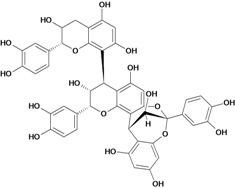
|
Stress-induced ulcers (water-immersion)/gastric intubation | Mouse | 500.0 mg/kg | Inactive [81] |
Cinnamtannin D-1
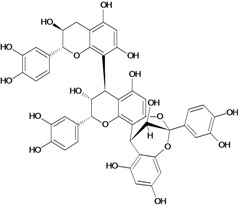
|
Stress-induced ulcers (water-immersion)/gastric intubation | Mouse | 500.0 mg/kg | Inactive [81] |
Procyanidin B-1
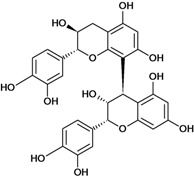
|
Stress-induced ulcers (water-immersion)/gastric intubation | Mouse | 500.0 mg/kg | Weak activity [81] |
Procyanidin B-2
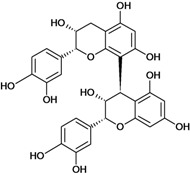
|
Stress-induced ulcers (water-immersion)/gastric intubation | Mouse | 200.0 mg/kg | Active [81] |
Procyanidin B-3
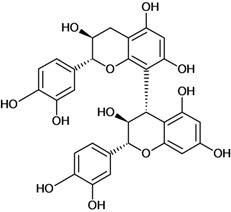
|
HCl/ethanol-induced stomach ulcers/intragastric | Rat | 200.0 mg/kg | Inactive [79] |
Procyanidin B-4
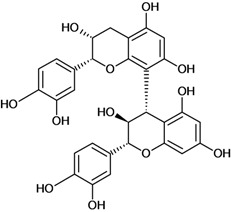
|
Stress-induced ulcers (water-immersion)/gastric intubation | Mouse | 500.0 mg/kg | Active [81] |
* Dates weren’t provided
Finally, nowadays it is known that NSAIDs, such as piroxicam or aspirin have several adverse effects on the gastrointestinal tract and increase the risk of myocardial infarction. However, several flavonoids have demonstrated anti-inflammatory properties, without showing any ulcerogenic action as a side effect, and thus showing a great advantage in the treatment of peptic ulcers.
Conclusions
Flavonoids represent a highly diverse class of secondary metabolites with potentially beneficial effects on human health. These compounds protect the gastrointestinal mucosa from lesions produced by various experimental ulcer models and against different necrotic agents. Several mechanisms of action may be involved in this protective effect. Quercetin has an anti-secretory mechanism of action. This flavonol has antihistaminic properties, thus, decreases histamine levels, as well as preventing the release of histamine from gastric mast cells and inhibiting the gastric H+/K+ proton pump, diminishing acid gastric secretion. On the other hand chalcones, in particular those with more than one isoprenyloxyl group, possess cytoprotective effects, which increase the mucosal blood flow, stimulate the synthesis of mucosubstances in the gastric mucosa and increase PGs levels. However, the most important mechanism of action responsible for the anti-ulcer activity of flavonoids is their antioxidant properties, seen in garcinol, rutin and quercetin, which involves free radical scavenging, transition metal ions chelation, inhibition of oxidizing enzymes, increase of proteic and nonproteic antioxidants and reduction of lipid peroxidation. These effects are correlated with presence in the structures of an o-dihydroxy in the ring B (catechol), and additionally a 2,3 double bond in conjugation with a 4-oxo function, as well as the presence hydroxyl groups in positions 3, 5 and 7. Besides the gastroprotective activity, sofalcone (a chalcone), quercetin and naringenin (flavanones) accelerate the healing of gastric ulcers. In addition, the two first polyphenolic compounds have anti-H. pylori activity and may be utilized as an alternative or additive agent to the current therapy. Therefore flavonoids could have an ideal more effective and less toxic therapeutic potential for the treatment of gastrointestinal diseases, particularly for peptic ulcers.
Acknowledgements
The authors would like to express their sincere thanks to Ms. Gabriela G. Barbosa for the revision of the English grammar and to College of Pharmacy, the University of Illinois at Chicago, U.S.A., for helping with the computer in the database NAPRALERT.
Footnotes
Sample availability: Not available.
References and Notes
- 1.Mayty P., Biswas K., Roy S., Barnergee R. K., Bandyopadhyay U. Smoking and pathogenesis of gastroduodenal ulcer-recent mechanistic update. Mol. Cell. Biochem. 2003;253:329–338. doi: 10.1023/a:1026040723669. [DOI] [PubMed] [Google Scholar]
- 2.Prados C. M.A., Miquel D.B. Úlcera péptica. Rev. Esp. Enferm. Dig. 2004;96:81–82. doi: 10.4321/s1130-01082004000100011. [DOI] [PubMed] [Google Scholar]
- 3.Bandyopadhyay D., Biswas K., Bhattacharyya M., Reiter R.J., Banerjee R.K. Gastric toxicity and mucosal ulceration induced by oxygen-derived reactive species, protection by melatonin. Curr. Mol. Med. 2001;1:501–513. doi: 10.2174/1566524013363483. [DOI] [PubMed] [Google Scholar]
- 4.Bhattacharjee M., Bhattacharjee S., Gupta A., Banerjee R.K. Critical role of an endogenous gastric peroxidase in controlling oxidative damage in H. pylori-mediated and non-mediated gastric ulcer. Free Radical Biol. Med. 2002;32:731–743. doi: 10.1016/s0891-5849(02)00757-8. [DOI] [PubMed] [Google Scholar]
- 5.Konturek P.C., Konturek S. Role of Helicobacter pylori infection in gastro-duodenal secretion and in pathogenesis of peptic ulcer and gastritis. J. Physiol. Pharmacol. 1994;45:333–350. [PubMed] [Google Scholar]
- 6.Wallace J.L., Granger D.N. The cellular and molecular basis of gastric mucosal defense. FASEB J. 1996;10:731–740. doi: 10.1096/fasebj.10.7.8635690. [DOI] [PubMed] [Google Scholar]
- 7.Calam J., Baron J. H. Pathophysiology of duodenal and gastric ulcer and gastric cancer. Brit Med J. 2001;323:980–983. doi: 10.1136/bmj.323.7319.980. [DOI] [PMC free article] [PubMed] [Google Scholar]
- 8.Liu C., Crawford J. M. Patologia–Bases patológicas das doenças. In: Kumar V., Abbas A.K., Fausto N., editors. Robbins & Cotran. Volume 7. Elsevier; Rio de Janeiro, Brazil: 2005. pp. 851–857. [Google Scholar]
- 9.Rao C.H.V., Ojha S.K., Radhakrishnan K., Govindarajan R., Rastogi S., Mehrotra S., Pushpangadan P. Antiulcer activity of Utleria salicifolia rhizome extract. J. Ethnopharmacol. 2004;91:243–249. doi: 10.1016/j.jep.2003.12.020. [DOI] [PubMed] [Google Scholar]
- 10.Bandyopadhyay D., Biswas K., Bhattacharyya M., Reiter R.J., Banerjee R.K. Involvement of reactive oxygen species in gastric ulceration, protection by melatonin. Indian J. Exp. Biol. 2002;40:693–705. [PubMed] [Google Scholar]
- 11.Lehne R.A. Pharmacology for Nursing Care. W.B. Saunders; Philadelphia, USA: 1998. pp. 781–783. [Google Scholar]
- 12.Cechinel-Filho V., Yunes R.A. Breve análise histórica da Química de Plantas Medicinais: Sua importância na atual concepção de fármaco segundo os paradigmas Ocidental e Oriental. In: Yunes R.A., Calixto J.B., editors. Plantas medicinais sob a ótica da química medicinal moderna. Argos Editora Universitária; Chapecó, Brazil: 2001. [Google Scholar]
- 13.Kanner J., Lapidot T. The stomach as a bioreactor: dietary lipid peroxidation in the gastric fluid and the effects of plantderived antioxidants. Free Radical Biol. Med. 2001;31:1388–1395. doi: 10.1016/s0891-5849(01)00718-3. [DOI] [PubMed] [Google Scholar]
- 14.Gurbuz I., Akyuz C., Yesilada E., Sener B. Anti-ulcerogenic effect of Momordica charantia L. fruits on various ulcer models in rats. J. Ethnopharmacol. 2000;71:77–82. doi: 10.1016/s0378-8741(99)00178-6. [DOI] [PubMed] [Google Scholar]
- 15.Cechinel Filho V., Yunes R.A. Estratégias para a obtenção de compostos farmacologicamente ativos a partir de plantas medicinais. Conceitos sobre modificação estrutural para otimização da atividade. Quim. Nova. 1998;21:1. [Google Scholar]
- 16.Czinner E., Hagymasi K., Blazovics A., Kery A., Szoke E., Lemberkovics E. The in vitro effect of Helichysi flos on microsomal lipid peroxidation. J. Ethnopharmacol. 2001;77:31–35. doi: 10.1016/S0378-8741(01)00258-6. [DOI] [PubMed] [Google Scholar]
- 17.Harborne J.B., Baxter H. Handbook of Natural Flavonoids. Wiley; Chichester, UK: 1999. p. 2. [Google Scholar]
- 18.Williams C.A., Grayer R.J. Anthocyanins and other flavonoids. Nat. Prod. Rep. 2004;21:539–573. doi: 10.1039/b311404j. [DOI] [PubMed] [Google Scholar]
- 19.Harborne J.B., Williams C.A. Advances in flavonoid research since 1992. Phytochemistry. 2000;55:481–504. doi: 10.1016/S0031-9422(00)00235-1. [DOI] [PubMed] [Google Scholar]
- 20.Hassig A., Liang W.X., Schwabl H., Stampfli K. Flavonoids and tannins plant-based antioxidants with vitamin character. Med. Hypotheses. 1999;52:479–481. doi: 10.1054/mehy.1997.0686. [DOI] [PubMed] [Google Scholar]
- 21.Martens S., Mithofer A. Flavones and flavone synthases. Phytochemistry. 2005;66:2399–2407. doi: 10.1016/j.phytochem.2005.07.013. [DOI] [PubMed] [Google Scholar]
- 22.Dewick P. M. Medicinal Natural Products: a biosynthetic approach. John Wiley; Chichester, UK: 2002. p. 150. [Google Scholar]
- 23.Buchanan B., Gruissem W., Jones R. Biochemistry & Molecular Biology of Plants. American Society of Plant; Physiologists, USA: 2000. p. 1304. [Google Scholar]
- 24.Havsteen B.H. The biochemistry and medical significance of the flavonoids. Pharmacol. Ther. 2002;96:67–202. doi: 10.1016/S0163-7258(02)00298-X. [DOI] [PubMed] [Google Scholar]
- 25.Beecher G.R. Overview of dietary flavonoids: nomenclature, occurrence and intake. J. Nutr. 2003;133:3248S–3254S. doi: 10.1093/jn/133.10.3248S. [DOI] [PubMed] [Google Scholar]
- 26.Ross J.A., Kasum Dietary flavonoids: bioavailability, metabolic effects, and safety. Annu. Rev. Nutr. 2002;22:19–34. doi: 10.1146/annurev.nutr.22.111401.144957. [DOI] [PubMed] [Google Scholar]
- 27.Yang C.S., Landau J.M., Huang M.T., Newmark H.L. Inhibition of carcinogenesis by dietary polyphenolic compounds. Annu. Rev. Nutr. 2001;21:381–406. doi: 10.1146/annurev.nutr.21.1.381. [DOI] [PubMed] [Google Scholar]
- 28.Manach C., Morand C., Demigne C., Texier O., Regerat F., Rémésy C. Bioavailability of rutin and quercetin in rats. FEBS Lett. 1997;409:12–16. doi: 10.1016/S0014-5793(97)00467-5. [DOI] [PubMed] [Google Scholar]
- 29.Critchfield J.W., Butera S.T., Folks T.M. Inhibition of HIV activation in latently infected cells by flavonoid compounds. AIDS Res. Hum. Retrovir. 1996;12:39–46. doi: 10.1089/aid.1996.12.39. [DOI] [PubMed] [Google Scholar]
- 30.Cheong H., Ryu S.Y., Oak M.H., Cheon S.H., Yoo G.S., Kim K.M. Studies of structure activity relationship for the anti-allergic actions. Arch. Pharmacal Res. 1998;21:478–480. doi: 10.1007/BF02974647. [DOI] [PubMed] [Google Scholar]
- 31.Carotenuto A., Fattorusso E., Lanzotti V., Magno S., De Feo V., Cicala C. The flavonoids of Allium neapolitanum. Phytochemistry. 1997;44:949–957. doi: 10.1016/S0031-9422(96)00663-2. [DOI] [PubMed] [Google Scholar]
- 32.Lima J.T., Almeida J.R.G.S., Barbosa-Filho J.M., Assis T.S., Silva M.S., Dacunha E.V.L., Braz-Filho R., Silva B.A. Spasmolytic action of diplotropin, a furanoflavan from Diplotropis ferruginea Benth., involves calcium blockade in ginea-pig ileum. Z. Naturforsch. B. 2005;60:1–8. [Google Scholar]
- 33.Di Carlo G., Autore G., Izzo A.A., Maiolino P., Mascolo N., Viola P., Diurno M.V., Capasso F. Inhibition of intestinal motility and secretion by flavonoids in mice and rats: structure-activity relationships. J. Pharm. Pharmacol. 1993;45:1054–1059. doi: 10.1111/j.2042-7158.1993.tb07180.x. [DOI] [PubMed] [Google Scholar]
- 34.La Casa C., Villegas I., Alarcon De La Lastra C., Motilva V., Martin Calero M.J. Evidence for protective and antioxidant properties of rutin, a natural flavone, against ethanol induced gastric Lesions. J. Ethnopharmacol. 2000;71:45–53. doi: 10.1016/S0378-8741(99)00174-9. [DOI] [PubMed] [Google Scholar]
- 35.Barnaulov O.D., Manicheva O.A., Komissarenko N.F. Comparative evaluation of the effect of some flavonoids on changes in the gastric wall of reserpine-treated or immobilized mice. Pharm Chem. 1983;17:946–951. [Google Scholar]
- 36.Barnaulov O.D., Manicheva O.A., Shelyuto V.L., Konopleva M.M., Glyzin V.I. Effect of flavonoids on development of experimental gastric dystrophies in mice. Khim Farm Zh. 1985;18:935–941. [Google Scholar]
- 37.Izzo A.A., Di Carlo G., Mascolo N., Capasso F. Antiulcer effect of flavonoids: role of endogenous PAF. Phytother Res. 1994;8:179–181. [Google Scholar]
- 38.Hirano H., Takase H., Yamamoto K., Abe K., Saito J. Nobiletin as ulcer inhibitor. Patent-Japan Kokai Tokkyo Koho-06 72. 1994 870, 4.
- 39.Larson R.A. The antioxidants of higher plants. Phytochemistry. 1998;27:969–978. [Google Scholar]
- 40.Sahu S. Pro-oxidant activity of flavonoids: effects on glutathione and glutathione S-transferase in isolated rat liver nuclei. Cat. Inist. 1996;104:193–196. doi: 10.1016/0304-3835(96)04251-6. [DOI] [PubMed] [Google Scholar]
- 41.Yoshino K., Suzuki M., Sasaki K., Miyase T., Sano M. Formation of antioxidants from (-)-epigallocatechin gallate in mild alkaline fluids, such as authentic intestinal juice and mouse plasma. J. Nutr. Biochem. 1999;10:223–229. doi: 10.1016/S0955-2863(98)00103-X. [DOI] [PubMed] [Google Scholar]
- 42.Kyogoku K., Hatayama K., Yokomori S., Saziki R., Nakane S., Sasajima M., Sawada J., Ohzeki M., Tanaka I. Anti-ulcer effect of isoprenyl flavonoids. II. Synthesis and anti-ulcer activity of new chalcones related to sophoradin. Chem. Pharm. Bull. 1979;27:2943–2953. doi: 10.1248/cpb.27.2943. [DOI] [PubMed] [Google Scholar]
- 43.Sasajima M., Nakane S., Saziki R., Saotome H., Hatayama K., Kyogoku K., Tanaka I. Studies on the anti-ulcer effects of isoprenyl flavonoids. I. The anti-ulcer effects of isoprenyl chalcone extracted from Sophora subprostrata. Nippon Yakurigaku Zasshi. 1978;74:897–905. doi: 10.1254/fpj.74.897. [DOI] [PubMed] [Google Scholar]
- 44.Kimura M., Saziki R., Arai I., Tarumoto Y., Nakane S. Effect of z-carboxymethoxy-4,4'-bis (3-methyl-2-butenyloxy) chalcone (sofalcone) on chronic gastric ulcers in rats. JPN. J. Pharmacol. 1984;35:389–396. doi: 10.1254/jjp.35.389. [DOI] [PubMed] [Google Scholar]
- 45.Saziki R., Kyogoku K., Hatayama K., Suwa T., Sawada J. Anti-ulcer activities of su-88, a compound related to sophoradin isolated from guang-dou-gen. J. Pharmacobio-Dynam. 1983;6:S-59. [Google Scholar]
- 46.Saziki R., Arai I., Isobe Y., Hirose H., Aihara H. Effects of sofalcone on necrotizing agents-induced gastric lesions and on endogenous prostaglandins in rat stomachs. J. Pharmacobio-Dynam. 1984;7:791–797. doi: 10.1248/bpb1978.7.791. [DOI] [PubMed] [Google Scholar]
- 47.Sunairi M., Watanabe K., Suzuki T., Tanaka N., Kuwayama H., Nakajima M. Effects of anti-ulcer agents on antibiotic activity against Helicobacter pylori. Eur J Gastroenterol Hepatol. 1994;6(Suppl 1):S121–S124. [PubMed] [Google Scholar]
- 48.Nagate T., Numata K., Hanada K., Kondo I. The susceptibility of Campylobacter pylori to agents and antibiotics. J Clin Gastroenterol. 1990;12(Suppl 1):S135–S138. doi: 10.1097/00004836-199001001-00023. [DOI] [PubMed] [Google Scholar]
- 49.Isomoto H., Furusu H., Ohnita K., Wen Chun-Yang., Inoue K., Kohno S. Sofalcone, a mucoprotective agent, increases the cure rate of Helicobacter pylori infection when combined with rabeprazole, amoxicillin and clarithromycin. World J. Gastroenterol. 2005;11:1629–1633. doi: 10.3748/wjg.v11.i11.1629. [DOI] [PMC free article] [PubMed] [Google Scholar]
- 50.Lewis D.A., Fields W.N., Shaw G.P. A natural flavonoid present in unripe plantain banana pulp (Musa sapientum L. var. paradisiaca) protects the gastric mucosa from aspirin-induced erosions. J. Ethnopharmacol. 1999;65:283–288. doi: 10.1016/S0378-8741(99)00005-7. [DOI] [PubMed] [Google Scholar]
- 51.Lewis D.A., Shaw G.P. A natural flavonoid and synthetic analogues protect the gastric mucosa from aspirin-induced erosions. J. Nutr. Biochem. 2001;12:95–100. doi: 10.1016/S0955-2863(00)00133-9. [DOI] [PubMed] [Google Scholar]
- 52.Yamaguchi F., Saito M., Ariga T., Yoshimura Y., Nakazawa H. Free radical scavenging activity and antiulcer activity of garcinol from Garcinia indica Fruit Rind. J. Agric. Food Chem. 2000;48:2320–2325. doi: 10.1021/jf990908c. [DOI] [PubMed] [Google Scholar]
- 53.Guerrero C.P., Martin M.J., Marhuenda E. Prevention by rutin of gastric lesions induced by ethanol in rats, role of endogenous prostaglandins. Gen. Pharmacol. 1994;25:575–580. doi: 10.1016/0306-3623(94)90217-8. [DOI] [PubMed] [Google Scholar]
- 54.Rao C.V., Govindarajan S.K.O.R., Rawat A.K.S., Mehrotra S., Pushpangadan P. Quercetin, a bioflavonoid, protects against oxidative stress-related gastric mucosal damage in rats. Nat. Prod. Sci. 2003;9:68–72. [Google Scholar]
- 55.Barnaulov O.D., Manicheva O.A., Yasinov R.K., Yakovlev G.P. Evaluation of the effect of flavonoids from the aerial parts of Astragalus quisqualis bunge and A. floccosifolius sumn on the development of experimental lesions in the mouse stomach. Rast. Resur. 21:85–90. [Google Scholar]
- 56.Martin M.J., Motilva V., Alarcon De La Lastra C. Quercetin and naringenin, effects on ulcer formation and gastric secretion in rats. Phytother. Res. 1993;7:150–153. doi: 10.1002/ptr.2650070211. [DOI] [Google Scholar]
- 57.Barnaulov O.D., Manicheva O.A., Zapesochnaya G.G., Shelyuto V.L., Glyzin V.I. Effects of certain flavonoids on the ulcerogenic action of reserpine in mice. Khim. Farm. Zh. 1982;16:300–303. [Google Scholar]
- 58.Alarcon De La Lastra C., Martin M.J., Motilva V. Antiulcer and gastroprotective effects of quercetin., a gross and histologic study. Pharmacology. 1994;48:56–62. doi: 10.1159/000139162. [DOI] [PubMed] [Google Scholar]
- 59.Martin M.J., La-Casa C., Alarcon De La Lastra C., Cabeza J., Villegas I., Motilva V. Anti-oxidant mechanisms involved in gastroprotective effects of quercetin. Z. Naturforsch. C J. Biosci. 1998;53:82–88. doi: 10.1515/znc-1998-1-215. [DOI] [PubMed] [Google Scholar]
- 60.Kahraman A., Erkasap N., Koken T., Serteser M., Aktepe F., Erkasap S. The antioxidative and antihistaminic properties of quercetin in ethanol-induced gastric lesions. Toxicology. 2003;183:133–142. doi: 10.1016/S0300-483X(02)00514-0. [DOI] [PubMed] [Google Scholar]
- 61.Beil W., Birkhoiz C., Sewing K.F. Effects of flavonoids on parietal cell acid secretion, gastric mucosal prostaglandin production and Helicobacter pylori growth. Arzneim. Forsch. 1995;45:697–700. [PubMed] [Google Scholar]
- 62.Motilva V., Alarcon De La Lastra C., Calero M.J.M. Effects of naringenin and quercetin on experimental chronic gastric ulcer in rat studies on the histological findings. Phytother. Res. 1992;6:168–170. [Google Scholar]
- 63.Russo A., Acquaviva R., Campisi A., Sorrenti V., Di Giacomo C., Virgata G., Barcellona M.L., Vanella A. Bioflavonoids as antiradicals, antioxidants and DNA cleavage protectors. Cell Biol. Toxicol. 2000;16:91–98. doi: 10.1023/A:1007685909018. [DOI] [PubMed] [Google Scholar]
- 64.Pietta P.G. Flavonoids as antioxidant. J. Nat. Prod. 2000;62:1035–1042. doi: 10.1021/np9904509. [DOI] [PubMed] [Google Scholar]
- 65.Yamamoto K., Kakegawa H., Ueda H., Matsumoto H., Sudo T., Miki T., Satoh T. Gastric cytoprotective anti-ulcerogenic actions of hydroxychalcones in rats. Planta Med. 1992;58:389–393. doi: 10.1055/s-2006-961498. [DOI] [PubMed] [Google Scholar]
- 66.Ortega C.A., Maria A.O.M., Gianello J.C. Chemical components and biological activity of Bidens subalternans, B. aurea (Astereaceae) and Zuccagnia puntacta (Fabaceae) Molecules. 2000;5:465–467. [Google Scholar]
- 67.De La Rocha N., Maria A.O.M., Gianello J.C., Pelzer L. Cytoprotective effects of chalcones from Zuccagnia punctata and melatonin on the gastroduodenal tract in rats. Pharmacol. Res. 2003;48:97–99. doi: 10.1016/S1043-6618(03)00063-X. [DOI] [PubMed] [Google Scholar]
- 68.Kyogoku K., Hatayama K., Yokomori S., Seki T. Isoprenylchalcones. Patent-Japan Kokai-75. 1975;24:257. [Google Scholar]
- 69.Kyogoku K., Hatayama K., Yokomori S., Seki T. Isoprenylchalcones. Patent Japan Kokai 75. 1975b;24:258. [Google Scholar]
- 70.Hatayama K., Yokomori S., Kawashima Y., Saziki R., Kyogoku K. Anti-ulcer effect of isoprenyl flavonoids. III. Synthesis and anti-ulcer activity of metabolites of 2'-carboxymethoxy-4,4'-Bis(3-methyl-2-butenyloxy) chalcone. Chem. Pharm. Bull. 1985;33:1327–1333. doi: 10.1248/cpb.33.1327. [DOI] [PubMed] [Google Scholar]
- 71.Murakami S., Kotomo S., Ozawa M., Baba K. Novel chalcone derivative as antiulcer agent. Patent Japan Kokai Koho 04. 1992;29:968. [Google Scholar]
- 72.Parmar S., Hennings G. Perfect of 3-methoxy-5,7,3'4'-tetrahydroxyflavan on the healing of restraint ulcers in albino rats. IRCS Med. Sci-Biochem. 1984;12:393–394. [Google Scholar]
- 73.Kyogoku K., Tachi Y., Hatayama K., Ohtake T. Novel flavanone from Sophora angustifolia. Patent Japan Kokai 74. 1974;126:809. [Google Scholar]
- 74.Suarez J., Herrera M.D., Marhuenda E. Hesperidin and neohesperidin dihydrochalcone on different experimental models of induced gastric ulcer. Phytother. Res. 1996;10:616–618. doi: 10.1002/(SICI)1099-1573(199611)10:7<616::AID-PTR897>3.0.CO;2-N. [DOI] [Google Scholar]
- 75.Parmar N.S. The Gastric Anti-Ulcer Activity of Naringenin, a specific histidine decarboxylase inhibitor. Int. J. Tissue React. 1984;5:415–420. [PubMed] [Google Scholar]
- 76.Galati E.M., Monforte M.T., D'aquino A., Miceli N., Di Mauro D., Sanogo R. Effects of naringin on experimental ulcer in rats. Phytomedicine. 1998;5:361–366. doi: 10.1016/S0944-7113(98)80018-4. [DOI] [PubMed] [Google Scholar]
- 77.Martin M.J., Marhuenda E., Perez-Guerrero C., Franco J.M. Antiulcer effect of naringin on gastric lesions induced by ethanol in rats. Pharmacology. 1994;49:144–150. doi: 10.1159/000139228. [DOI] [PubMed] [Google Scholar]
- 78.Fomum Z.T., Ayafor J.F., Mbafortj, Mbi C.N. Erythrina studies. Part 6. Pharmacological studies on sigmoidin a, b and c, novel flavanones isolated from Erythrina sigmoidea. Rev. Sci. Technol. (Health Sci. Ser.) 1984;1:55–68. [Google Scholar]
- 79.Saito M., Hosoyama H., Ariga T., Kataoka S., Yamaji N. Antiulcer activity of grape seed extract and procyanidins. J. Agric. Food Chem. 1998;46:1460–1464. doi: 10.1021/jf9709156. [DOI] [Google Scholar]
- 80.Parmar N.S., Ghosh M.N. The antiinflammatory and anti-gastric ulcer activities of some bioflavonoids. Bull Jawaharlal Inst. Post-Grad. Med. Educ. Res. 1976;1:6–11. [Google Scholar]
- 81.Ezaki N., Kato M., Takizawa N., Morimoto S., Nonaka G.I., Nishioka I. Pharmacological studies on linderae umbellatae ramus, IV. Effects of condensed tannin related compounds on peptic activity and stress-induced gastric lesions in mice. Planta Med. 1985;51:34–38. doi: 10.1055/s-2007-969386. [DOI] [PubMed] [Google Scholar]
- 82.Yamazaki M., Okuyama E., Matsudo T., Takamaru T., Kaneko T. Principles of indonesian herbal drugs having an antiulcerogenic activity. I. Isolation and identification of (+)-catechin from Artocarpus integra merr. Yakugaku Zasshi. 1987;107:914–916. doi: 10.1248/yakushi1947.107.11_914. [DOI] [PubMed] [Google Scholar]
- 83.Parmar N.S., Ghosh M.N. Gastric antiulcer activity of methyl-3-(+)-catechin. Stud. Org. Chem. (Amsteram). 1982;11:513–521. [Google Scholar]
- 84.Balint G. A., Gabor M., Nafradi J., Varro V. Interaction of 3-o-mehtyl-(+)-catechin and H2-receptor blockers in piroxican- and indomethacin-induced gastric ulcer models of rat. Stud. Org. Chem. 1985;23:453–456. [Google Scholar]
- 85.Parmar N.S., Ghosh M.N. Gastric anti-ulcer activity of (+)-cyanidanol-3, a histidine decarboxylase inhibitor. Eur. J. Pharmacol. 1981;69:25–32. doi: 10.1016/0014-2999(81)90598-7. [DOI] [PubMed] [Google Scholar]
- 86.Kolhir V.K., Bykov V.A., Baginskaja A.I., Sokolov S.Y., Glazova N.G., Leskova T.E., Sakovich G.S., Tjukavkina N.A., Kolesnik Y.A., Rulenko I.A. Antioxidant activity of a dihydroquercetin isolated from Larix gmelinii(Rupr.) Rupr. wood. Phytother. Res. 1996;10:478–482. [Google Scholar]
- 87.Magistretti M.J., Conti M., Cristoni A. Antiulcer activity of an anthocyanidin from Vaccinium myrtillus. Arzneim. Forsch. 1988;38:686–690. [PubMed] [Google Scholar]
- 88.Rainova L., Nakov N., Bogdanova S., Minkov E., Staneva-Stoytcheva D. Ulceroprotective activity of the flavonoids of Genista rumelica Vel. Phytother. Res. 1988;2:137–139. doi: 10.1002/ptr.2650020307. [DOI] [Google Scholar]
- 89.Lee E.B., Kang S.S. Antigastritis and antiulcer agent containing eupatilin, and isolation thereof. Patent Repub. Korea. 1994;127:777. [Google Scholar]
- 90.Villar A., Gasco M.A., Alcaraz M.J. Anti-inflammatory and anti-ulcer properties of hypolaetin-8-glucoside, a novel plant flavonoid. J. Pharm. Pharmacol. 1984;36:820–823. doi: 10.1111/j.2042-7158.1984.tb04884.x. [DOI] [PubMed] [Google Scholar]
- 91.Villar A., Gasco M.A., Alcaraz M.J., Manez S., Cortes D. Hypolaetin-8-o-glucoside, an anti-inflammatory flavonoid from Sideritis mugronensis. Planta Med. 1985;51:70–71. doi: 10.1055/s-2007-969399. [DOI] [PubMed] [Google Scholar]
- 92.Alcaraz M.J., Tordera M. Studies on the gastric anti-ulcer activity of hypolaetin-8-glucoside. Phytother. Res. 1988;2:85–88. doi: 10.1002/ptr.2650020208. [DOI] [Google Scholar]
- 93.Takase H., Yamamoto K., Hirano H., Saito Y., Yamashita A. Pharmacological profile of gastric mucosal protection by marmin and nobiletin from a traditional herbal medicine, Aurantii fructus immaturus. JPN J. Pharmacol. 1994;66:139–147. doi: 10.1254/jjp.66.139. [DOI] [PubMed] [Google Scholar]
- 94.Hirano H., Takase H., Yamamoto K., Yanase T., Abe K., Saito Y. The anti-ulcer effects of Aurantii fructus immaturus, Aurantii fructus and the principles in Aurantii fructus immaturus. Nat. Med. 1997;51:190–193. [Google Scholar]
- 95.Cen D.Y., Chen Z.W., Wang Y.L., Wang Q., Li Q.J., Song B.W. Protective effects of rutoside on gastric mucosa and influence on nitric oxide and prostaglandin. Chin. Pharm. Bull. 1999;15:360–362. [Google Scholar]
- 96.Meng D.S., Wnag S.L. Protective effects of quercetin, rutoside, and flavone against intestinal mucosal injury induced by burns in mice. Chin. Pharm. Bull. 2000;16:673–675. [Google Scholar]
- 97.Okuyama E., Yamazaki M., Ishii Y. Isolation and identification of ursolic acid-related compounds as the principles of glechoma hederacea having an antiulcerogenic activity. Shoyakugaku zasshi. 1983;37:52–55. [Google Scholar]
- 98.Rao V.S.N., Santos F.A., Sobriera T.T., Souza M.F., Melo C.L., Silveira E.R. Investigations on the gastroprotective and antidiarrhoeal properties of ternatin, a tetramethoxyflavone from Egletes viscosa. Planta Med. 1997;63:146–149. doi: 10.1055/s-2006-957632. [DOI] [PubMed] [Google Scholar]
- 99.Yamahara J., Mochizuki M., Chisaka T., Fujimura H., Tamai Y. The antiulcer action of sophora and the active constituent in sophora. II. The antiulcer action of vexibinol. Chem. Pharm. Bull. 1990;38:1039–1044. doi: 10.1248/cpb.38.1039. [DOI] [PubMed] [Google Scholar]
- 100.Goel R.K., Maiti R.N., Tavares I.A. Role of endogenous eicosanoids in the antiucler effect of kaempferol. Fitoterapia. 1996;67:548–552. [Google Scholar]
- 101.Goel R.K., Pandey V.B., Dwivedi S.P.D., Rao Y.V. Antiinflammatory and antiulcer effects of kaempferol, a flavone, isolated from Rhamnus procumbens. Indian J. Exp. Bio. 26;1988:121–124. [PubMed] [Google Scholar]
- 102.Di Carlo G., Mascolo N., Izzo A.A., Capasso F. Effects of quercetin on the gastrointestinal tract in rats and mice. Phytother. Res. 1994;8:42–45. [Google Scholar]



